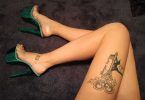Pole dancing is a dynamic and empowering art form that combines strength, grace, and athleticism. However, for many enthusiasts, pole dance bruises are a common and often expected part of the journey. These marks serve as a testament to progress but can also cause discomfort, requiring proper care to heal and prevent them from becoming a setback.
What Causes Pole Dance Bruises?
Bruises, medically known as contusions, are caused by damage to tiny blood vessels under the skin. In pole dancing, these bruises occur primarily due to repeated gripping, twisting, and pressure on specific areas of the body. When a dancer grips the pole tightly or spins, the skin, and underlying tissues experience significant force, leading to localized bruising. Common “pole bruises” occur on the thighs, shins, forearms, and even the inner arms and ribs. Understanding the common causes of pole dance bruises can help you adjust your technique and prevent them.
Understanding Different Types of Pain in Pole Dancing
Pole dancing introduces various types of discomfort, each signaling something different about your technique or body’s condition:
- Muscle Soreness: Often felt a day or two after training, muscle soreness indicates your muscles are adapting and growing stronger.
- Bruises and Contusions: These are superficial and generally heal within a few days, though large bruises can take longer.
- Joint or Tendon Pain: Pain in joints or tendons can indicate improper form or overuse. These pains require rest and possibly a reassessment of technique.
- Skin Burns: Caused by friction with the pole, skin burns are most common during spins and slides. Protective measures like grip aids and clothing can help prevent them.
Understanding these types of pain is crucial, as it helps you gauge when to push through and when to pause to prevent injury.
Healing and Managing Pole Dance Bruises: Essential Techniques
Applying Cold Compresses
When you first notice a bruise, a cold compress is one of the most effective treatments to reduce swelling and prevent the bruise from deepening. Ice packs or even a cold, damp towel applied to the affected area constrict blood vessels, reducing blood flow to the bruise site. Try to apply a cold compress for 10-15 minutes immediately after training.
Using Arnica Gel and Other Topical Treatments
Arnica gel, a homeopathic remedy derived from the Arnica montana plant, is celebrated for its ability to reduce inflammation and encourage healing. Apply it directly to bruises after training. Similarly, creams containing vitamin K and bromelain, derived from pineapples, may accelerate healing.
Elevating the Bruised Area
Elevation can also help reduce swelling by allowing blood and lymphatic fluid to flow away from the bruised site. While this may be challenging for certain areas like the thighs, propping up a leg or elevating an arm can provide relief and prevent the bruise from darkening.
Staying Hydrated and Nourished
Hydration supports healthy blood flow, skin elasticity, and the body’s natural healing processes. A well-balanced diet rich in vitamins C and E, as well as antioxidants, can help repair damaged tissues. Citrus fruits, nuts, seeds, and leafy greens are great for supporting skin and blood vessel health.
Preventing Injuries and Reducing Pole Dance Bruises
Building Up Strength Gradually
One of the most effective ways to avoid injuries in pole dancing is by building up your strength gradually. Focus on strengthening core muscles, shoulders, and legs through bodyweight exercises, such as planks, squats, and pull-ups. Strong muscles provide better support during difficult moves and reduce strain on vulnerable areas.
Proper Warm-Ups and Stretching
A thorough warm-up prepares muscles for the dynamic movements in pole dancing while stretching post-session improves flexibility and reduces soreness. Include stretches focused on the upper body, lower body, and core to enhance mobility, which can reduce the likelihood of injury.
Take your technique to the next level with online pole dance classes from Open Dance Academy focused on form and injury prevention. Learn from experienced instructors on how to master each move safely and efficiently, helping you build strength, flexibility, and confidence with every class. Perfect for all levels! Sign up here
Grip Aids and Skin Protection
Grip aids, such as liquid chalk or tacky gloves, can help with better grip on the pole, reducing the need for excessive pressure. This minimizes the likelihood of bruising and decreases the strain on the skin. For those prone to skin burns, wearing leg warmers, knee pads, or protective sleeves can help.
Treating Common Skin Injuries and Burns
Preventing and Treating Pole Burns
Pole burns occur when the skin experiences friction against the metal pole, especially during fast or spinning movements. To prevent these, consider using grip aids that minimize slipping. If a burn does occur, aloe vera gel and over-the-counter hydrocortisone cream can help soothe the skin. Avoid re-exposing the affected area until it has healed completely.
Healing Skin Tears and Abrasions
Skin tears and abrasions from pole dancing are painful and can lead to infection if untreated. Clean the affected area with mild soap and water, then apply an antibacterial ointment and cover it with a bandage. Avoid exposing the injured skin to the pole until it’s fully healed to prevent further injury.
Managing Soreness and Post-Pole Pain
Rest and Recovery
Resting after an intense pole session is crucial to allow muscles to repair and rebuild. Ideally, dancers should have at least one rest day between sessions. Adding gentle stretching and foam rolling on off-days can aid in recovery without putting excessive strain on the body.
Epsom Salt Baths and Magnesium for Muscle Relief
Soaking in an Epsom salt bath after pole dancing can help relax sore muscles and reduce inflammation. Magnesium in Epsom salts also aids muscle relaxation and recovery, relieving aches and improving circulation. Additionally, magnesium supplements, if approved by a healthcare professional, may aid in reducing soreness.
Using a Foam Roller for Pain Relief
Foam rolling, a type of myofascial release, helps break down scar tissue and alleviates tension in tight muscles. Roll slowly over sore muscles after a pole workout to help alleviate tightness and reduce the potential for injury. A foam roller is especially helpful for areas like the upper back, thighs, and calves.
Benefits of Consistent Recovery Practices for Pole Dancers
Maintaining a regular recovery routine is essential in pole dancing, as it allows your muscles and tissues to rebuild, making you stronger and more resilient. Regular recovery can also help prevent common pole injuries, such as rotator cuff strains and lower back pain. Dedicating time to recovery means you can train consistently without facing setbacks from pain and injury.
Top Foods for Quick Pole Dance Bruises Healing and Pain Management
Nutrition plays a significant role in healing and pain management. Foods that help speed up recovery from bruising and inflammation include:
- Pineapple: Contains bromelain, which can reduce swelling and bruising.
- Citrus Fruits: Rich in vitamin C, which is crucial for collagen production and tissue repair.
- Dark Leafy Greens: High in vitamin K, which aids in blood clotting and faster bruise healing.
- Fish and Nuts: Provide omega-3 fatty acids, known to reduce inflammation.
- Garlic and Ginger: Natural anti-inflammatories that can reduce pain and speed up recovery.
Including these foods regularly in your diet can support your body’s natural healing processes and help reduce bruising and muscle soreness.
Mental Resilience: Embracing the Challenges of Pole Dancing
The physical demands of pole dancing are mirrored by its mental challenges. The process of learning to cope with bruises, skin tears, and soreness can be tough but rewarding. Practicing mindfulness, setting realistic goals, and acknowledging each small victory can enhance mental resilience, making the journey more enjoyable and fulfilling. Embracing both the joys and the discomforts of pole dancing builds character, determination, and discipline.
Healing the Bruise: A Guide to Listening to Your Body in Pole Dance
Ultimately, pole dancing is as much about body awareness as it is about skill. Being attuned to your body’s signals and knowing when to rest, recover, or adjust your technique can significantly reduce the risks of injury. With time and practice, you’ll develop a deeper understanding of what your body needs to perform its best and stay injury-free.
Frequently Asked Questions about Pole Dance Bruises
How long do bruises from pole dancing usually take to heal?
Most bruises heal within one to two weeks, depending on the severity. Cold compresses and topical treatments like arnica gel can speed up the process.
Is bruising normal in pole dancing?
Yes, bruising is common, especially for beginners. Over time, your body may adapt, and bruising may become less frequent.
What can I do to prevent pole dance bruises?
Using proper grip, building strength gradually, and wearing protective gear can reduce the likelihood of bruising.
Are there specific foods that help with bruise recovery?
Yes, foods high in vitamins C, K, and E, as well as those with anti-inflammatory properties, can support faster healing.
Should I be worried about joint pain in pole dancing?
Joint pain may signal improper form or overuse. If the pain persists, consult a healthcare provider to assess your technique and training.
Can foam rolling help with pole dancing-related pain?
Absolutely. Foam rolling can reduce muscle tightness, enhance flexibility, and aid in recovery after intense pole sessions.
Pole Dancing Bruises: Conclusion
Pain and bruising are natural components of pole dancing, but they don’t have to hinder progress. By adopting effective healing techniques, focusing on prevention, and maintaining a balanced approach to recovery, you can thrive in this vibrant art form while keeping your body healthy and resilient. With dedication, self-care, and mindful practice, you’ll be well-equipped to face the challenges and joys that come with pole dancing.
References:








